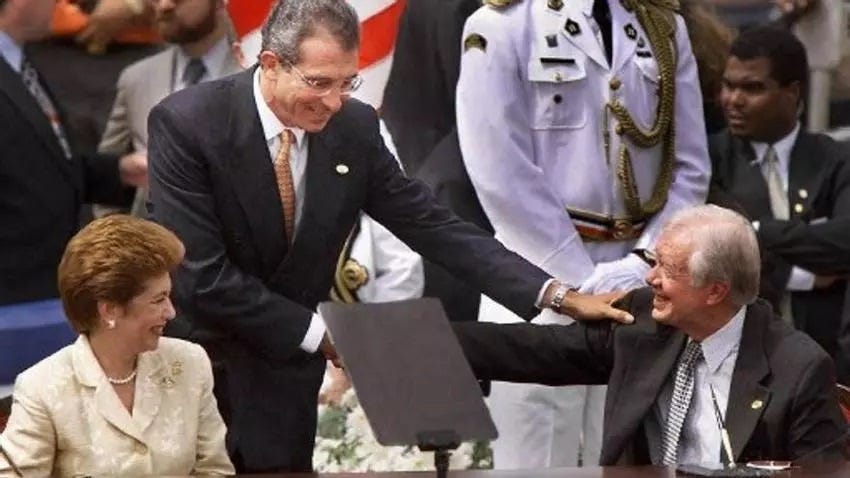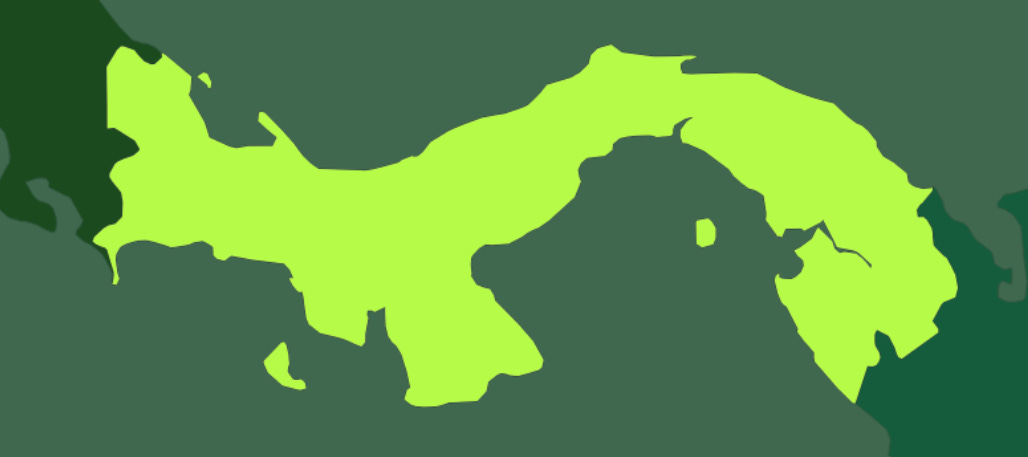The Panama Canal: A Monument to Chinese Labour, Not U.S. Manifest Destiny
Panama belongs to Panamanians, not Trump's Imperial aspirations. Let's talk about how U.S. Imperialism and Chinese sacrifice shaped Panama’s destiny.
Donald Trump’s inauguration speech was replete with the language of ‘manifest destiny’, as he vowed to ‘take back’ the Panama Canal and expand US territory. It is unsurprising that the new President views the oceanic canal through the prism of US dominance. But there is another - lesser known - story about the canal, centred on the blood, toil, and tears of the Chinese workers who built a canal and would go on to shape Panama's future.
In 1956 President Dwight D. Eisenhower observed regarding the US Panama Canal Zone, “The world moves, and ideas that were good once are not always good.” Later, the recently deceased President Jimmy Carter wrote “Why don’t we get out of Panama gracefully, before we are kicked out? He would go on to secure the agreement where the Canal would finally be handed back to Panama by 1999.
Both men recognised the reality that for the United States to occupy the canal zone, a strip of territory slicing Panama in two was unsustainable. Moreover, Jimmy Carter clearly understood the damaging history surrounding the Canal for the USA, and how continued US control over it eroded American reputation, credibility and soft-power across the world.
Unfortunately the wheel of history sometimes turns in ways not desired. In this case taking us down a cul-de-sac where Donald Trump feels a pressing need to ‘manifest’ his nation’s ‘destiny’, a-la 1903. But the reality is that for Panamanians the Canal is a story about the dichotomy between US imperialism and the ordinary Chinese workers who died helping to build a young nation.
‘El Chino’: Chinese immigrants as the sui generis class of exploited workers
Compared to other Latin American countries, Panama has a substantial population of Chinese origin numbering 200,000. Although, if considering the total numbers of Panamanians with at least a measure of Chinese ancestry, the total number is likely much higher.
Anthropologists specialising in the migration of work groups tells us why, taking us back to 1854 when Chinese labourers were contracted to the Panama railroad. The ‘Trans-Panama railroad’ proved a lethal workplace given the majority of the initial 1,000 Chinese labourers either perished from diseases, suicides or were ultimately moved away to Cuba. In March 30th, 1854 approximately 750 Chinese labourers boarded the ship “Sea Witch”, to be the first Chinese workers for railway work to link both oceans across the Isthmus. The ship sailed from Shantou (China) and during the 61 day sailing 11 Chinese passengers perished. These ships would become known as the “floating hells” among the Chinese workers which needed to use them. The “Sea Witch” of the Holland and Aspinwall line was but one example during the mid to late 19th Century where Chinese workers were exposed to inhuman conditions aboard the hell ships. But those who survived would go on to lay the foundations for every Chinese Panamanian.
The 1880s witnessed a rising pace of Chinese labourers being brought in as a French oceanic canal project was attempted. Although the ill-fated French attempt at linking the Caribbean and Pacific via oceanic canal would prove disastrous, nevertheless many of these Chinese workers chose to remain after their ‘contracts’ failed alongside French hubris. Between 1878 when Colombia (then ruling Panama) signed a concession with French engineers to build the canal and 1899 - when the French finally admitted comprehensive defeat- approximately 22,000 workers perished.
To illustrate how horrendous the conditions were, Colon, known as Aspinwall by English speakers, was so notorious that the Quad-City Times on Sunday 20 December 1903 published a short piece warning about it. “The village is built on low swampy ground, and is totally undrained”, going on to warn “It has no system of sewage, and an inadequate water supply.”
The fate for many Chinese and Afro-Caribbeans labourers would be a place known as the Monkey Hill Cemetery, or Mount Hope as it is known today. It became the burial ground for the black West Indian immigrants who died working on the intercontinental Panama Railroad for the American Panamanian Railroad Corporation between 1850 and 1855. As work began on the canal, first with the French Canal Company (1880–1889) and later during the American period (1904–1914), the cemetery became the resting place for thousands of labourers who had succumbed to appalling working conditions.
The story of how and why thousands of Chinese labourers ended up in the Isthmus connecting north and south America is a tragic story, and not as well known as the Afro-Caribbean story. Chinese immigrants had become a sui generis - class of workers of their own. Coming from the oldest civilisation on earth, they came from a country which was culturally advanced which transmitted knowledge intergenerationally; a fact popular with white would-be employers who boasted Chinese workers would work harder than the coloured workers they brought in from Jamaica, Cuba. Naturally such views from white western employers were as much about how easy exploitable these workers were as much as racism. Many Chinese labourers to Panama between 1850s-1940 were desperately trying to escape social marginalisation and poverty at home. And thanks to British imperialist cruelties inflicted on late Qing dynastical China, opium addition was rampant among the Chinese working populace.
In one recorded case, when the directors of the Panama Railway Company in New York learned about the cost of the opium they had contractually agreed to have distributed daily to the Chinese labourers, they abruptly suspended the supply, worsening the emotional situation of these immigrants. Suicide rates skyrocketed, deaths from diseases such as malaria and cholera were rampant amid squalid inhuman working conditions in the swampy tropics.
In 1903 the USA requested their own concession to attempt construction of a canal, only to be rebuffed by Colombia which viewed the financial terms as unacceptable. As a result, President Roosevelt responded by ignoring Colombian sovereignty, dispatching two warships to Panama City and Colón to support Panamanian independence. When Colombian troops realised they were were unable to negotiate the jungles of the Darién Gap, the loss of Panama rapidly became a fait accompli and Panama declared independence on November 3, 1903.
It just so happened that after Washington had supported and resourced Panamanian independentism, within three days of their independence, the Panamanian ambassador to Washington D.C signed a treaty granting the U.S. rights to build and control the canal. This episode of cynical US imperialism in Latin America also opened the door to fresh waves of what western employers viewed as cheap, exploitable Chinese labourers for construction.
Although a 1903 Panamanian law prohibiting Chinese immigration was passed, nevertheless Chinese immigration would continue throughout the 20th Century, helped along at least in part by those already living there. Many of these immigrants would go on to specialise in commerce, getting heavily involved in small retail businesses. They became so ingrained in Panamanian local culture in this aspect that the Panamanian Spanish term for retail or ‘corner shop’ is ‘el chino’.
By the time the nationalist President Arnulfo Arias took control of Panama periodically in the 1940s, a new constitution was passed revoking the Panamanian citizenship of non-Hispanic immigrants. Naturally for the Chinese Panamanians this drastic step by the state, coupled with simmering anti-Chinese racism reached a head by in 1941 approximately 1,000 Chinese Panamanians were forced to leave their country with citizenship stripped (restored finally in 1946).
Building Panama
When Donald Trump in his 2025 inauguration speech said "We didn't give it to China. We gave it to Panama, and we're taking it back,", he revealed layers of ignorance which remain remarkable.
The reality is that Chinese blood, toil, and tears constructed the Panama Canal and helped lay the foundations for small-scale Panamanian retail culture. And Panama today is a sovereign state which since 1999 has fully controlled and operated the oceanic canal with competence despite problems such as the drought conditions making operating it a challenge.
In 1997 when a 25-year contract was granted to Hong-Kong based Hutchinson Ports Holdings to manage the ports of Balboa on the Pacific side and Cristobal on the Atlantic entrance there was no reaction. Not only were there no objections from Washington D.C, there is scant evidence many even noticed Hutchinson was announced winner. Further, no American firms bid on the contract. It is more than passing strange that anti-China Warhawks in Washington D.C today, amid all the rhetoric about ‘peace’ and a ‘new golden era’ are pointing hysterically to the Hutchinson Ports Holdings contract. Did they simply not notice this Chinese-originated business presence until now? Or was it fine for the last 28 years for Chinese businesses to do commerce in a sovereign Panama but now no longer?
When the official ceremony handing over the Canal to Panama took place in December 1999, the USA was represented by Jimmy Carter, who had been out of office for 20 years, to represent the U.S. at the handover ceremony. The stage was now set for a new, Panamanian-run Canal with new international partners, including China.

The new stage is one where WASP (white, Anglo-Saxon, Protestant) America can no longer issue diktats to Latin American countries. The Panamanian Republic of 2025 is not in the same weak position as Colombia was in 1903, there is no possibility of Trump doing a Roosevelt and simply sending in a few gunboats.
As Michael McFaul, the former US ambassador to Russia under Obama observed recently, "You can’t be a president of peace and take back the Panama Canal,"
The reality is that the oceanic canal is Panamanian now, and China does not own or control it. However there are Chinese commercial businesses operating in and around the Canal Zone; but how is this anything new? The Panama Canal was built on the backs of thousands of Chinese labourers, you can go visit their graves at Monkey mountain. Given China is the second largest economy on the planet, it is obvious that the canal as an artery of global trade is as important for Beijing as Washington D.C. The only difference between the two is, the former has a history of helping build modern Panama whereas the latter merely has a legacy of imperial overlord exploiting it.
My work is entirely reader-supported. To receive new posts and support my work, please consider becoming a free or paid subscriber
Alternatively why not make a one-off donation? All support is appreciate






The next 4 years are going to be interesting...
Panama Canal Treaty 1977
Art 3
“ The Republic of Panama, as territorial sovereign, grants to the United States of America the rights to manage, operate, and maintain the Panama Canal, its complementary works, installations, and equipment and to provide for the orderly transit of vessels through the Panama Canal. The United States of America accepts the grant of such rights and undertakes to exercise them in accordance with this Treaty and related agreements.”
“The United States … may …
Make and enforce all rules pertaining the passage of vessels through the Canal and other rules with respect to navigation and maritime matters, in accordance with this Treaty and related agreements. The Republic of Panama will lend its cooperation, when necessary, in the enforcement of such rules“